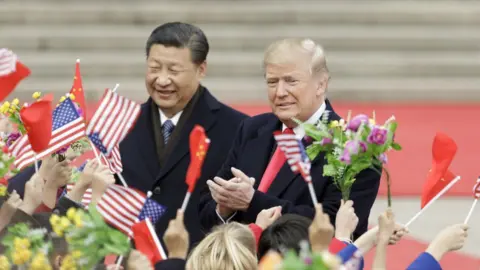Beijing Faces Economic Pressure Amid Trump’s Victory
China is preparing to unveil new economic measures to address its struggling economy, bracing for potential disruptions as Donald Trump returns to the White House. Trump’s campaign promises included tariffs as high as 60% on Chinese imports, threatening China’s recovery and its ambitious plans to become a global leader in technology.
Trump’s Trade Policies Could Undermine China’s Tech Growth
China’s economy has faced challenges, including a property slump, rising debt, unemployment, and low domestic spending. Xi Jinping’s administration had already taken steps to pivot toward high-quality, tech-driven growth, aiming to transition from rapid expansion to a sustainable economy powered by advanced manufacturing and green technology. Analysts warn that Trump’s planned tariffs could hinder this transition, weakening Xi’s long-term vision.

Past Tariffs and Rising Debt Create Economic Vulnerability
During Trump’s first term, Chinese exports to the U.S. were hit by tariffs as high as 25%. The Biden administration maintained many of these tariffs, heightening pressure on China’s economy, which has struggled to return to pre-pandemic growth. The International Monetary Fund (IMF) recently lowered its growth forecast for China, now anticipating a slowdown to 4.8% in 2024 and further deceleration in subsequent years.
Xi’s Strategy for High-Quality Growth Under Threat
Since 2017, Xi has promoted a shift from traditional exports to high-tech industries, a strategy now at risk due to potential trade disruptions. China has made strides in solar panel production, electric vehicles, and lithium-ion batteries, establishing itself as a world leader in these sectors. Analysts say that redirecting the economy toward consumer demand rather than exports could help insulate China from external shocks like Trump’s tariffs.
Western Pushback on Chinese Exports Grows
Even as China’s high-tech exports have bolstered its economy, resistance has grown from Western countries. Recently, the European Union raised tariffs on Chinese electric vehicles to as much as 45%. According to analysts, this reluctance among major trade partners could complicate China’s path to economic stability.
China’s Long-Term Economic Plans Face Major Hurdles
With Trump set to return to office, Beijing must evaluate whether its current economic measures will be enough to weather the impact of new U.S. trade policies. While China’s leaders may have anticipated a slowing of the nation’s rapid growth, experts say that without a shift toward sustainable, consumer-driven expansion, the Chinese economy may face long-term stagnation similar to Japan’s post-1990s challenges.
